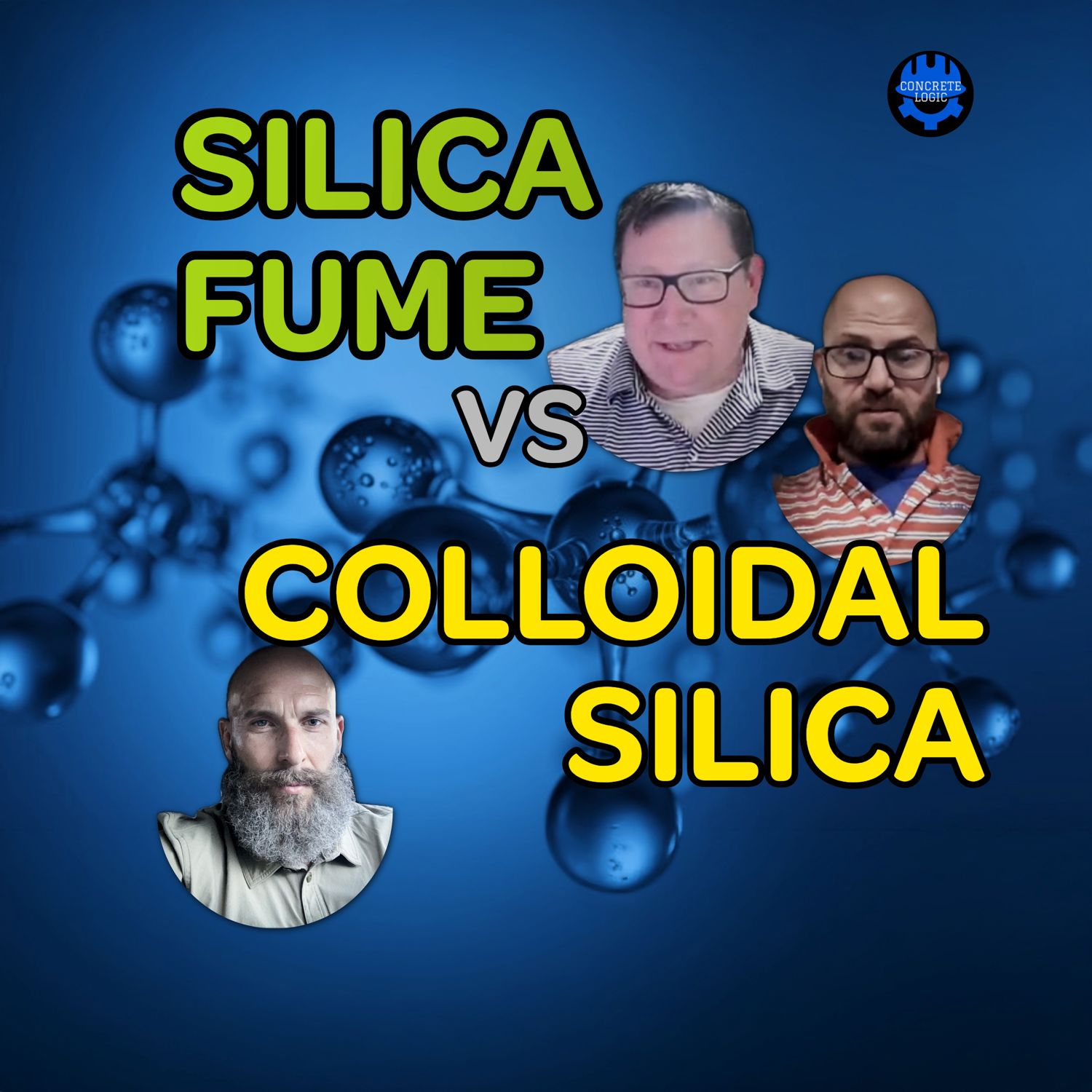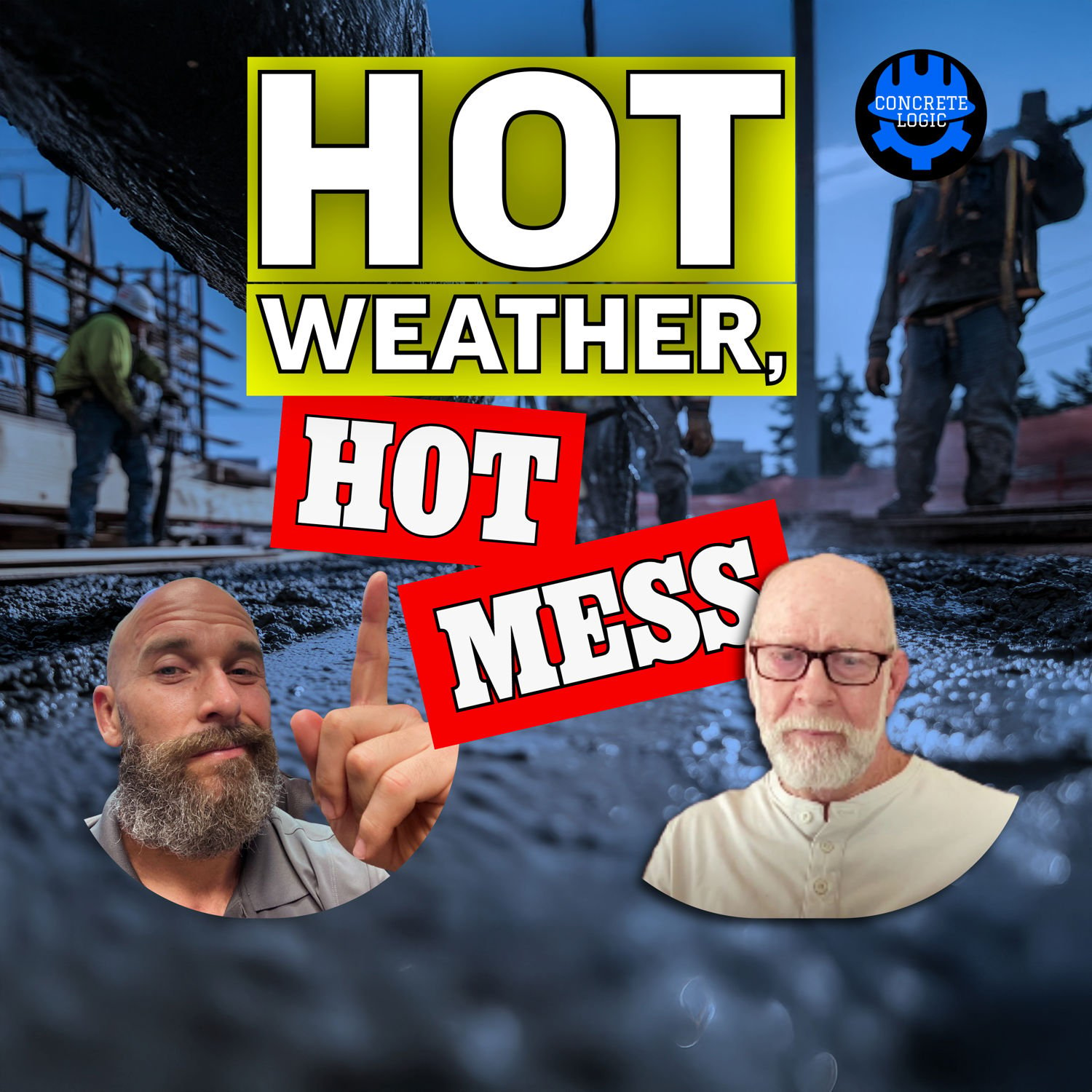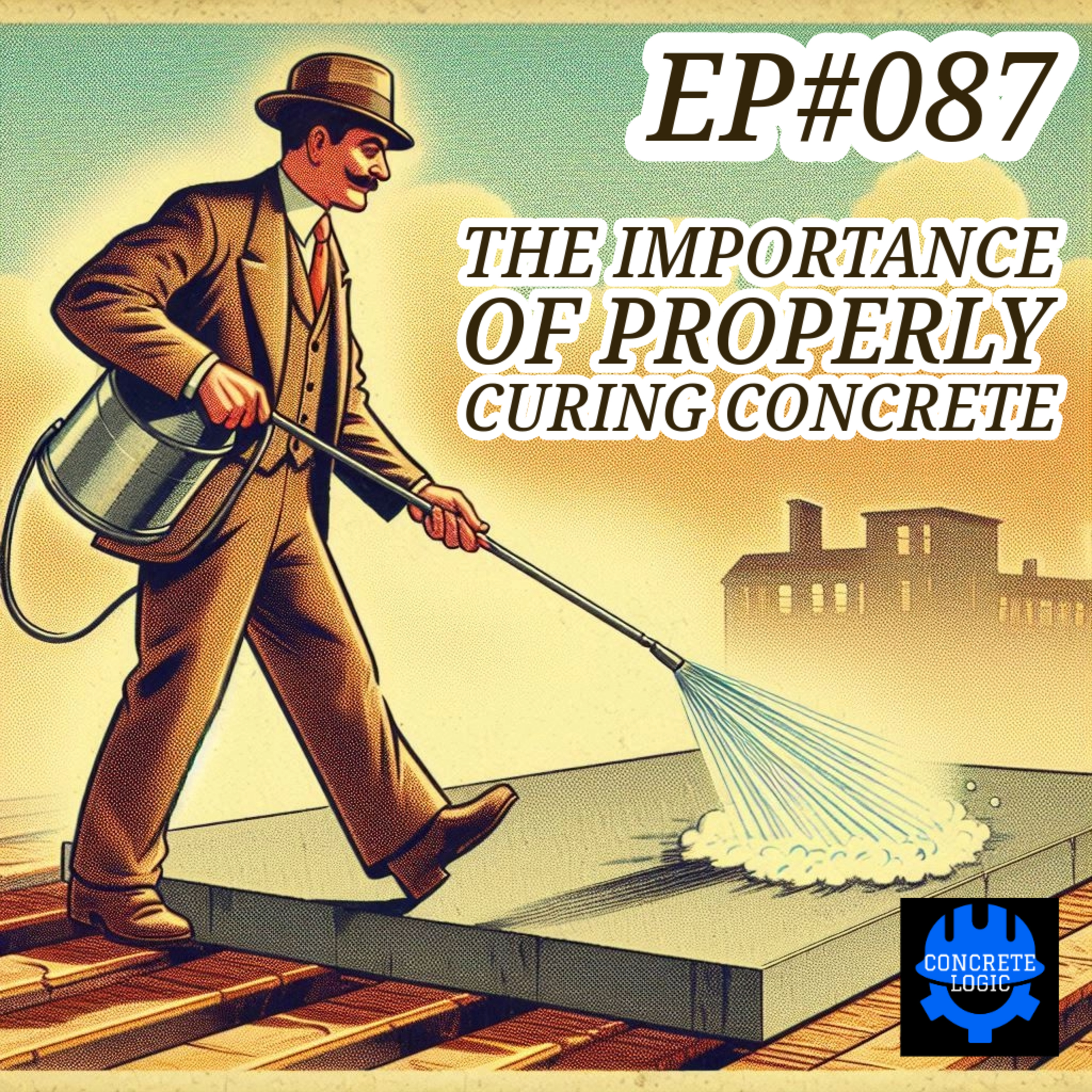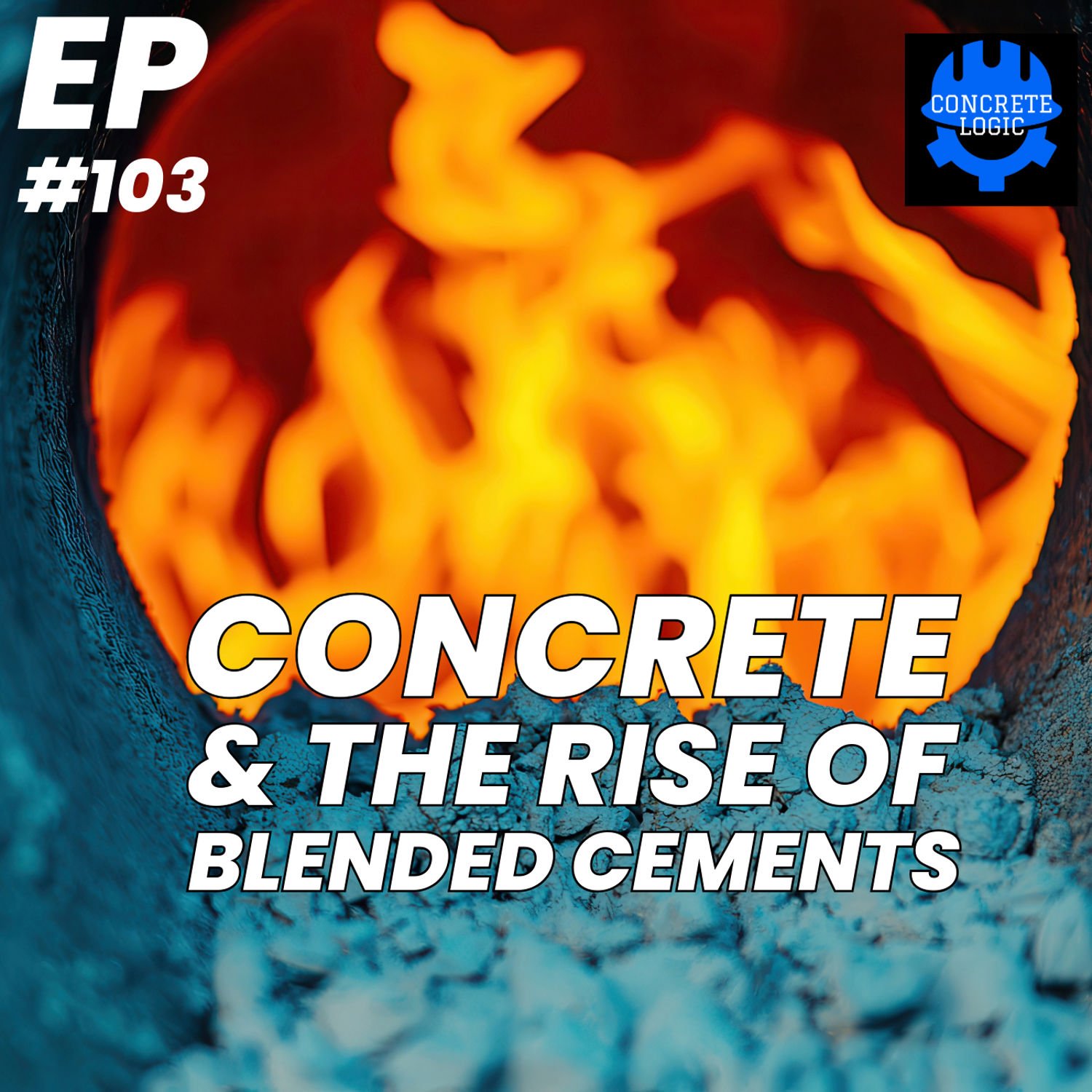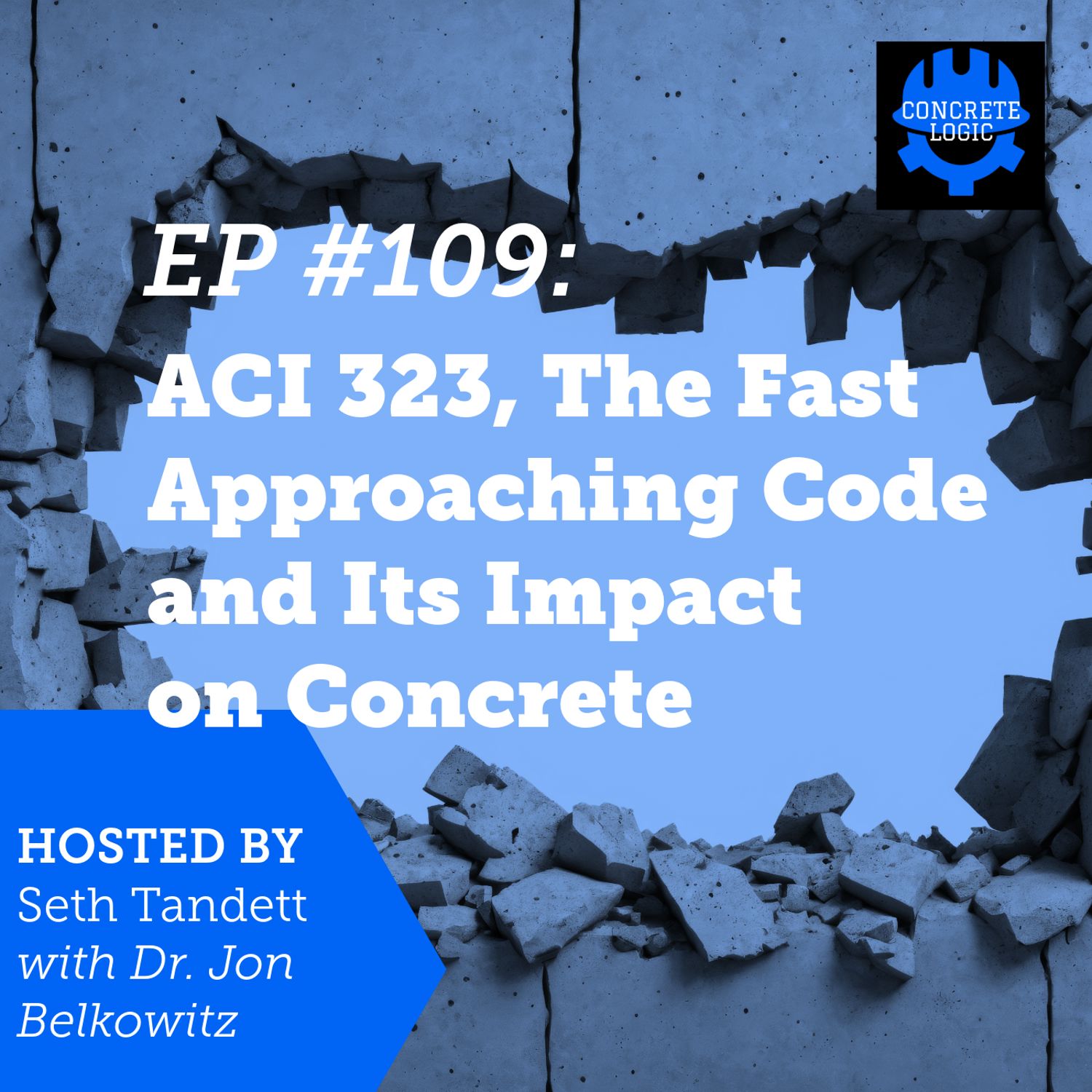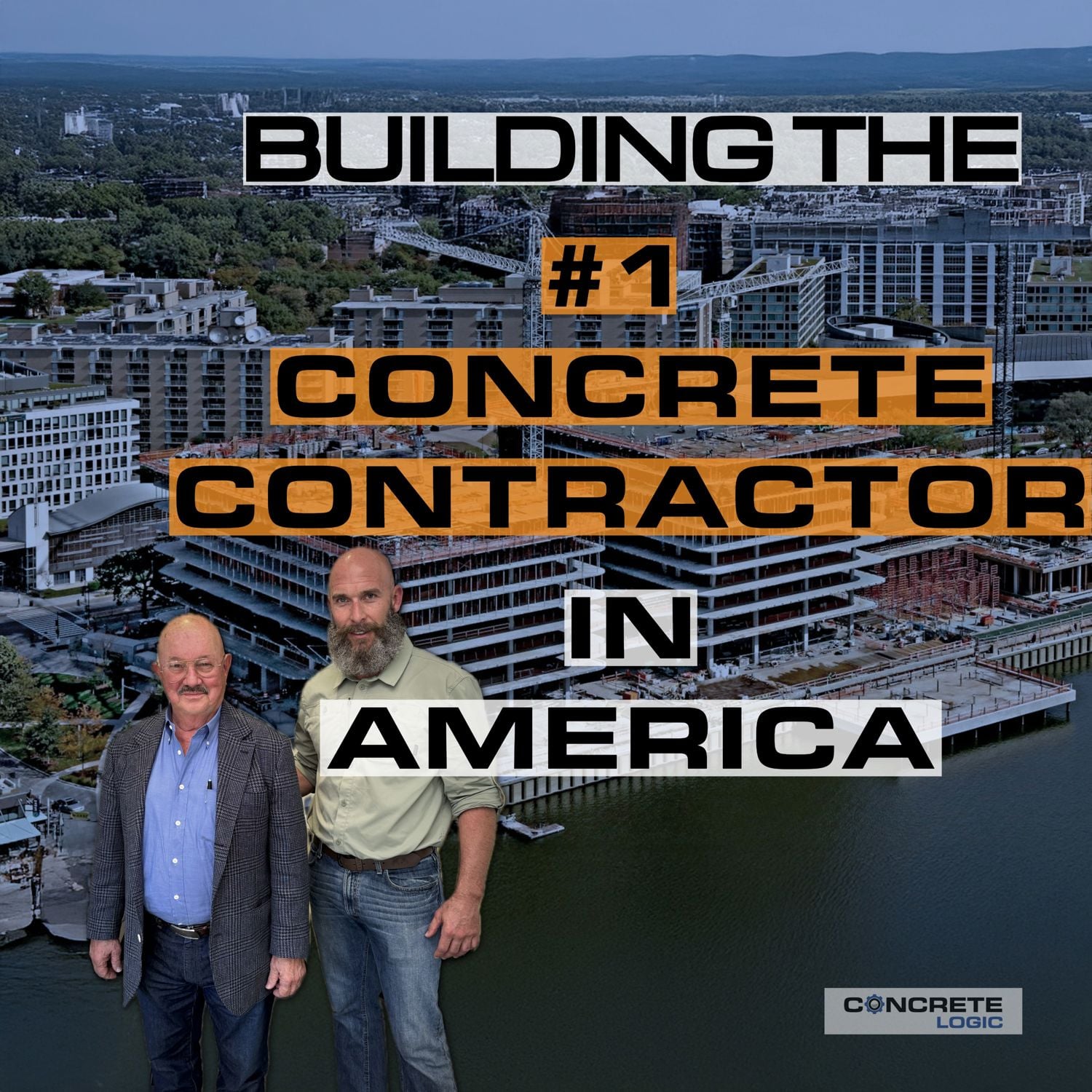EP #127: Why Type 1L Cement Is Causing Concrete Headaches
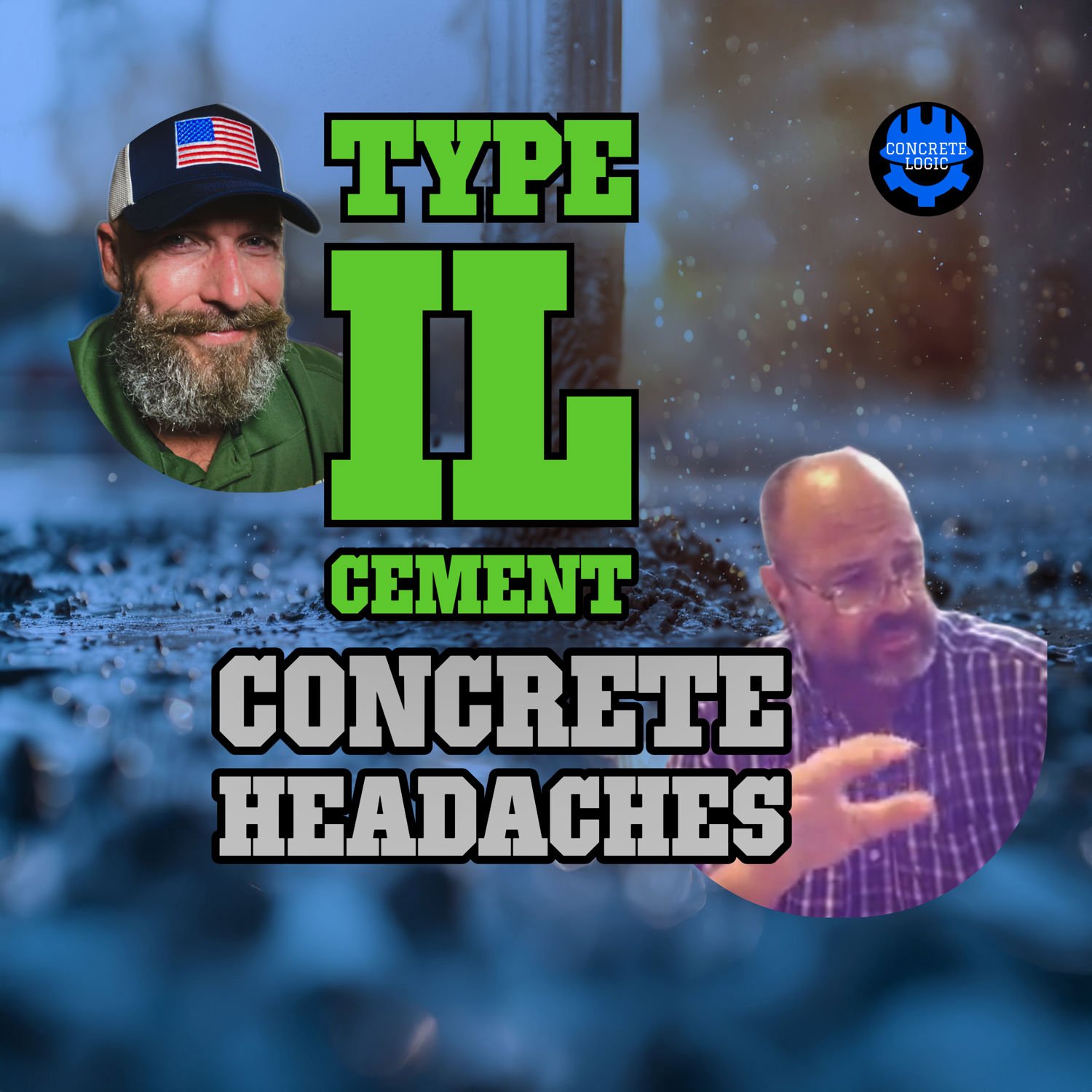
When concrete fails, who’s really at fault—the material or the people using it?
In this episode of the Concrete Logic Podcast, host Seth Tandett is joined by Dr. Jon and Rich to tackle the growing frustrations with Type 1L cement. They ask the hard questions: Is cement the problem? Are the specs off? Or is the industry just cutting corners? The conversation hits on the real-world consequences of poorly defined problems, regional quirks, and the disconnect between American and European concrete practices.
If you’re trying to figure out why your mix isn’t performing the way it used to, this one’s for you.
What You'll Learn
- Is Type 1L cement actually the problem—or is it how we're using it?
- How do regional differences change concrete performance?
- What lessons can we learn from European construction practices?
- Why might specs that look good on paper still cause problems in the field?
- How can you prevent the cumulative effects of small material changes from derailing a project?
Chapters
00:00 Introduction to Type 1L Cement Challenges
01:51 Defining the Problem: Material, Practitioner, or Other Factors
04:12 The Importance of Explicit Problem Definition
06:18 Regional Variations and Their Impact on Concrete Performance
08:39 The Role of Specifications and Methods in Concrete Quality
11:29 Comparing European and American Concrete Practices
13:53 The Need for Systematic Changes in Concrete Methods
16:48 Conclusion: A Holistic Approach to Concrete Issues
=============================
Take Your Knowledge Further – Join Concrete Logic Academy!
Gain access to expert video lessons, live Q&As, and professional development hours (PDHs). Learn what textbooks won’t teach you.
Start Learning: https://www.concretelogicacademy.com
Support the Podcast – Be Part of the Concrete Revolution!
Help us keep the Concrete Logic Podcast going strong. Your donation helps the entire concrete community get better and smarter.
Donate here: https://www.concretelogicpodcast.com
Want your company to sponsor the podcast? Learn how: https://www.concretelogicpodcast.com/p/partner-with-concrete-logic-podcast/
Guest: Rich Szecsy, Big Town Concrete
Guest Website: https://www.bigtownconcrete.com/
Producer: Tom Cummings, Jodi Tandett
Music by: Mike Dunton (Instagram: @Mike_Dunton)
Stay Connected & Watch More!
Host: Seth Tandett
Email: seth@concretelogicpodcast.com
LinkedIn: https://www.linkedin.com/in/seth-tandett/
YouTube: https://www.youtube.com/@concretelogicpodcast
Website: https://www.concretelogicpodcast.com
LIKE, SUBSCRIBE, COMMENT & SHARE for more concrete truth bombs.
00:26 - Introduction to Type 1L Cement Challenges
02:17 - Defining the Problem: Material, Practitioner, or Other Factors
04:38 - The Importance of Explicit Problem Definition
06:44 - Regional Variations and Their Impact on Concrete Performance
09:05 - The Role of Specifications and Methods in Concrete Quality
11:55 - Comparing European and American Concrete Practices
14:19 - The Need for Systematic Changes in Concrete Methods
17:14 - Conclusion: A Holistic Approach to Concrete Issues ============================= Take Your…
Seth Tandett (00:00)
And welcome to another episode of the Concrete Logic Podcast. And today I have two of my favorite guests, Dr. Jon and Rich Sagey. ⁓ We're going to talk about one of our favorite subjects, ⁓ but maybe not in the way you think we are, just based on past podcasts. But we're going to discuss why folks are having problems with type 1L and why others aren't. ⁓
And we're going to specifically talk about is it the material, is it the practitioner, or is it something else?
Is that what we all agreed on? We agreed on those three. Yeah, yeah, yeah.
Rich (00:37)
Yeah.
We get through a third of that, I'll be impressed.
Seth Tandett (00:42)
Yeah, well, we're on a we're on a clocks because we got to get rich to his lunch. So let's let's get into it. So. ⁓ So again, just to cover or to. Say what we're going to talk about again, so everybody stays on track because the three of us, ⁓ that's that's hard for us. ⁓ We are going to discuss why folks are having problems with type one else emit and why others aren't. Is it the material?
Is it the practitioner or is it something else? Ready, go, Dr. Jon.
Rich (01:12)
Yeah.
Seth Tandett (01:14)
Yep, barely, you're going in and out.
Rich (01:14)
yeah.
Seth Tandett (01:16)
It's on your side.
Rich (01:17)
you
Seth Tandett (01:19)
⁓ we lost him. ⁓ he's back. So do you know where he was going? And he can join us back.
Rich (01:21)
Yeah. So I do.
And so what Jon was referring to is we had an issue in 20.
regarding a cement shortage and 1L was being introduced in a big way. And I went and did the homework. I ran the mix designs. I ran the tests. I had the data. I partnered with some cement companies that also had data. And we had before we started really rolling it out, we had a good gamut of data ⁓ and understood what challenges and differences there might be under certain conditions. ⁓ And so that's what he's kind of referring to is I did the homework and I think that's what
takes is to do the homework and it's hard to understand the importance and power of the homework in a low-bid environment at the speed at which construction occurs. And I'm not saying somebody's doing something wrong I'm just saying to make things ⁓ to have things done right you have to take the time to do it and make the investment. But I think as you framed it going in Seth of it's the definition of the problem first.
⁓ And I'll give you two quick examples that we're all very familiar with is Seth I'm going to put you in the contractor as my customer position and I'm going to be your supplier producer and you call me up and you say hey Rich I got low breaks what are you going to do about it? And my response is what do you mean Seth? Where do you first where do we have low breaks on which one of the 17 jobs I'm doing?
Two, ⁓ what does low brakes mean? Does that mean below design strength? Does that mean below assumed strength? When you say brakes, that's plural. So we must have consecutive ones or there's a scattering of it. ⁓ And so you haven't defined the problem at all for me. I'll give you another great example that we're probably all familiar with. Hey, Rich, there's cracks on the surface of the concrete. What are you going to do about it?
what type of cracks are we talking about? haven't given me enough, you haven't defined the problem. And I think one L, as Jon was referring to and you were kind of framing up front, I'm still trying to figure out when people say they have a problem and I'm asking them for the definition.
Hey, Rich, we've got low breaks when we use one else cement. OK, I go back to my earlier example. You didn't have to tell me what else cement. You just had to say low breaks. then we can we can kind of get into that. and Jon loves when I refer to this is if I go back 15 years ago and I look at some of the letters I had to write to contractors or purchasers, they mentioned low breaks. They mentioned cracks. They mentioned strength gain. They mentioned setting time. They mentioned polishing issues. ⁓ These are not
Seth Tandett (03:45)
Yeah.
Rich (04:07)
new issues. So again, tell me the definition be explicit, not implicit. ⁓ And then we can get to sort things out. ⁓ The second part about that isn't any forensic investigation. ⁓ We have to go through the same number of steps. We don't skip steps. ⁓ We don't make assumptions. ⁓
I'll give you great example. Hey, Rich, we've got low breaks. ⁓ man. Let's go right to the materials. well, we forgot to cure it correctly. ⁓ well, gosh, we were already blaming materials when we figured out that wasn't cured correctly. No. Or we figured out that, hey, by the way, the last time the machine was calibrated was three years ago. Well, gosh, that's a long way to get. We don't skip steps in the forensic investigation. We try to be explicit. What happens is
people want the answers faster. That doesn't imply we skip steps.
And then the other thing I always find fascinating about this issue is, and again, I'm going to use you and I as the two examples here, Seth, is that you're the purchaser of the concrete for me. And let's say you're in a contracting role, right, or subcontracting role. You purchase, I manufacture and supply. That is where the agreement is. And so I always am amazed when there's other people involved, the general contractor, the engineer, the architect, the specifier, hell, even the
association to want to say hey we're going to insert ourselves into the conversation between the producer and the purchaser. Well you and I both know from a business perspective that's where we're going to sort it out. Now I will you and I can go out to the additional resources of the testing lab, the engineer, the architect, the specifier, ⁓ even the trade associations. But at the end of the day you and I are
where the resolution is going to be. Now I may have to go to my material suppliers and ask some questions. You may have to go to your specifiers who said, hey, here's the methods that we've specified for use in the contracts that have been bid upon. But at the end of the day, you and I are going to sort it out. And that's where I come back to your first question you asked of, what's the problem?
Well, let's be explicit and let's go through a standard series of questions after you've told me you have a problem. I'm going to ask you whether it was low breaks, cracks, setting time, ⁓ durability issues. I'm to go through the same series of questions and the same series of steps to find out what that root cause was.
And is it going to be, well, you know, we had a one-two summit, now it was a one-L. I don't look at anecdotal responses as a cause. Does that make sense? It's the correlation is not causation argument.
⁓ You've stacked up 10 anecdotal examples of where somebody has used a 1L cement in concrete. By the way Seth, that's the other important distinction we need to make. Nobody makes anything out of 1L cement. You make it out of concrete. So automatically we have a composite material of aggregates, supplementary cementitious materials, admixtures, water, and a cement.
that are making this composite material. So it's not ever one thing. I go back to my forensic analysis. You look at everything, every time. ⁓
Seth Tandett (07:53)
but it's a large component of concrete, right? So it impacts those other things.
Rich (07:57)
Yes.
Valid point, fair point. I also, you and I have had this conversation before and I'm going to use my highly technical term, the finnickiness.
Some concrete can be more finicky than others for a variety of reasons. And if the cement, and let's just use that as an example, is the dominating ⁓ chemical underpinning of the whole ⁓ of concrete.
maybe we've got something that's more finicky, which means our methods need to be right. And this is one of the questions, the second question you asked, is it because of the materials or the practitioner side? Why do you think as a producer, every time we have a jobsite trailer meeting about low breaks, what's the first question I ask Jon? The first question I ask when you say we have low breaks. What's the first question?
Seth Tandett (08:53)
I would guess where are the cylinders being stored?
Rich (08:59)
Where are
the cylinders being stored? Now why do I ask that question? It's because the methods matter. And I'm not picking on that. I'm just saying, now you may tell me, I'm sorry, you wouldn't, others might, say, well, we've never had to worry about that before.
Seth Tandett (09:07)
Right.
Rich (09:18)
The results have been fine without doing that method, even though it's been prescribed. It's in the it's in the quote. It's in the spec. It's in the standard. The answer will be we've never had to do that before. Well, so you're telling me you have intentionally not followed something. The second part about that is, ⁓ hey, Rich, we've got low seven day breaks. The strengths are low at seven days.
Seth Tandett (09:31)
Yeah.
Rich (09:46)
What's the first question I'm going to ask you, Seth, when you tell me that? And I'm relating this to all things I've heard about 1L from ⁓ users. So what's the first question I'm going to ask you when you tell me you've got low seven-day breaks?
Seth Tandett (10:01)
Is it one cylinder? Is it the average of all cylinders? I mean, that's kind of where my head goes.
Rich (10:05)
⁓ Yeah,
my first, that's my second question. My first question is going to be, what was the seven day specification? Well, you know, Rich, we've always ⁓ thought that concrete gets 70 % of its strength in seven days. Where did you get that from, Seth? Please don't tell me experience. ⁓
Seth Tandett (10:25)
So you're
supposed to read the specs each time you do a job?
Rich (10:28)
You
So these are those kind of things where I think explicit matters because when there's a problem Seth, you, again I'm going to pick on you as a purchaser, you are going to come to me and go, hey Rich, you bid it that way. Ever used that phrase or heard that phrase before?
Seth Tandett (10:47)
Well, yeah,
I mean, we do put responsibility on the supplier to read the same specs that we read before we bid the job. Can't say you didn't read them before you priced the material to us,
Rich (10:58)
Right.
100 percent, which is why I go to the specs available at the time of quotation. Right. Is what was available to both of us at the time things were quoted. think that's a now again, I don't want to go down that rabbit hole too much because I want to come back to the original question you asked because it's so important. If we're going to look at a problem first, you have to be well defined.
and you have data to frame in a certain way. And I'll share with you a ready-mix secret, Seth, and this goes to the point of our subject matter today, is when you tell me you have a problem on your job, the ready-mix secret is you're not the first concern I have. The first concern I have is every yard of concrete that I produced that day that went to every customer. Do I have a systemic problem?
Do I are you the only one that had that problem? Because now I've got to figure out what's my order of magnitude.
And I've got to go check all those other places that concrete went to that day. So again, do I have a systemic problem? Once I've eliminated that, and I'm not saying I do completely because it's happened. Now I can focus on your problem. What problem do you have? So let's be explicit. What were the conditions? What were the challenges? What were the products? All of those things on that day at that time for you.
Seth Tandett (12:13)
Mm-hmm.
Rich (12:27)
And now all of a sudden it doesn't become anecdotal. It becomes very, very specific, explicit and data driven. And it's easier to define that way. But again, I don't like to deviate from the forensic evaluation. You asked these 10 questions, no matter what the problem is. And we can kind of get to root cause. And yeah.
Seth Tandett (12:45)
Wait, before you go on,
I think you hit an important point that I want to circle back to when we were talking about material. And since you are a supplier and we're kind of, I guess, not going specifically to how you are dealing with it, but I think if we look at it across the country and we're saying to ourselves, why do some folks have problems with type one l cement and while others don't?
And if we just look into the material itself, I think you hit on a good point that concrete itself has many components to it, right? So on top of the type 1L cement, it's got aggregate sand, water, admixtures, hocus pocus stuff that ReadyMix guys don't tell us they put in there. ⁓ That was a joke. That was a joke. Rich come on. there you go. But what I'm saying is, do you think that
Rich (13:31)
I was gonna say we put it in for free Seth.
Seth Tandett (13:39)
Because I've heard about a specific ⁓ region that's having problems over and over again. Do you think that type 1L cement ⁓ is having problems in certain regions of the area because it's reacting a certain way to the aggregates in the sand that are available to that region? Is that a possibility?
Rich (14:01)
you
Yeah. And let's talk about it ⁓ in a slightly different way. ⁓ Let's say I'm going to I can equate almost everything to barbecue just being from Texas. So let's say that ⁓ I buy a brisket from the same butcher every time consistently. ⁓ But I make my own rub and I use my own cracked pepper and I use my own coarse sea salt. I use my own garlic and these other things. And all of a sudden one day I decide to buy a generic form of the garlic and I buy a generic form of the
Seth Tandett (14:14)
Okay.
Rich (14:34)
the seesaw, a generic form of this. Have I changed all of it? No, but what I've done is made subtle changes along it, along the chain, and each one has a distinct impact. Collectively, cumulatively, they can have a significant impact.
But if I had just changed the cracked pepper and gone to a generic and stuck with the higher quality garlic or the higher quality salt, nobody would have known the difference in the brisket. But if I made changes along all of them, the cumulative impact could be significant. So let's go to the question you asked about a regional issue. If I have a marginally reactive SCM,
Or I have a very high fines aggregate that's available. And I mean talking on the sand or I have something that is high on my deleterious material. It's still within spec but very high. All of a sudden by tweaking the cement on one side of it that could be just the cumulative effect where in the concrete you see a very different result. This is high science Seth and little changes can have significant impact.
The same is true for ⁓ the fineness of the cement or the absorption of the cement. That can have a significant impact on the final on the concrete side. Now does that mean the concrete is going to be bad? No. I go all the way back to the point I made at the very beginning which was has anybody done the homework?
Has anybody done the homework and said, we need to run a couple of tests here. We need to look at the combination of our materials here.
I've had that happen before where the gradation on my aggregates, it's still within spec but all of a sudden gets very, very coarse and my purchaser says, hey Rich, we're really having trouble stitching this together at a four inch slump. What happened? It's rocky. I go, good, again, go through the equation, find out what's changed. Turns out the gradation, it's still within spec but it's gotten more coarse.
And all of sudden when I do my plus or minus 2 % on my batching and the coarseness of the aggregate changes and I'm at a four inch slump when they're used to pouring five, all of a sudden now they're like, hey, your concrete's horrible. Well, ⁓ it was subtle little cumulative effects that added up. So to your question about regionality, in some cases, I don't doubt that that's not true.
because you could be operating at the edges of what I would call the I don't want to say risk that's not the right word the
those cumulative effects, then all of sudden you hit a tipping point because it's not linear. That's the one thing we both know to be true about concrete. I can't turn one knob and get a linear response always. Sometimes I can turn a knob and I get a significantly different response. Take for example, retarder. I put in one ounce. I can retard this much. I put in two ounces. I retard a little bit more. I put in three ounces. It lays there for three days.
That's not a linear response. I think the same could be true to your point about regionality and where people are challenged with their mix designs and the performance of the concrete. Does that mean it can't be solved? Absolutely not. And I think that's the other thing I want to make sure we focus on is there's solutions out there and some of them are and I am very reluctant.
Seth Tandett (17:39)
All right.
Rich (18:01)
as an engineer, as a scientist, as a practitioner to say that prohibitions are a proper solution. I want to be very clear about that and I think we need to stay away from that. ⁓
Seth Tandett (18:14)
What do you mean by that prohibiting what?
Rich (18:18)
Let's say prohibiting the amount of limestone finds that could be in a cement for use. Well, it's a 595 as long as it's within spec it's within spec. Well, we're only going to use a type 1L if the limestone finds are below X. And Seth, I'll give you a great practical example where we saw this happen. Have you ever used a fly ash in concrete and you saw the spec that said no more than 20 % fly ash?
Seth Tandett (18:44)
I see that a lot. Not that percentage specifically, but I've seen specs where they tell you you can only have certain amount.
Rich (18:48)
But
Why did they do the test? Was there why not 21 %? Why not 22 %? Down in Texas, we'll see 20 % as a max. Where did that come from? What code standard, where did that originate from? Nah, there wasn't a test matrix that was run and everybody said all fly ashes doubt shall not exceed 20%. Somebody said that at one point in time as a knee jerk reaction to prohibit its use.
same kind of thing now is prohibitions are not effective use and you and I both know I'll ask you this question very specifically when you see a prohibition or a mandate or in a spec what does that automatically tell you from a cost standpoint to build something ⁓
Seth Tandett (19:35)
gonna be more expensive.
Rich (19:37)
Well, you sure you don't want to go the other way with that answer, Seth? You sure you don't want to go the the costs are going to go down with prohibitions or limits? No, you're 100 % accurate with that answer. 100%. And so to me, those are those. Again, I'll go back to your your question about regionality of use.
Seth Tandett (19:43)
Yeah.
Rich (19:56)
Is that possible? Absolutely. And we've seen that before with other materials. We've seen that with class F ashes or C ashes. We've seen that with supplementary cementitious materials. There was a reason why if somebody said, hey, Rich, you've got two choices on the type one, two cement, one, two cement from this source or this source. Which one do you want? All things being equal from a landed cost standpoint. I'm going to lean into option B versus A because I knew it performed differently.
So yes, again, not a new concept, but we also figured out how to work with it. And so when you tell me, hey, there's a regionality issue, OK, let's assume there is. Then let's work on how the solution is. Is the solution on the material side? Is the solution on the proportioning side? Is the solution on the methods side? It's the,
I got to ask one time, hey, Rich, can you use a volumetric mixing truck to pour a high rise structure? Yes. Is it the ideal thing to use? No. Hey, Rich, can you use a ready mix truck to do, you know, eighth of a yard patches along the highway for six hours? Yes. Is it ideal? No. There are practical solutions to these things. And so can there be regionality issues? Absolutely.
Can there also be regional solutions? That's also an absolute ⁓ truth as well. ⁓ You just got to do the homework. You got to do the homework. ⁓
Seth Tandett (21:30)
Right.
But our methods have not changed since the new cement was introduced.
Rich (21:35)
⁓ agreed as well. And I will tell you, you and I are just about at that age where we can also look back and go, you know, two decades ago, ⁓ we did this. Now we don't anymore. 10 years ago, we did this. Now we don't anymore. It's okay for methods to change. But one of the challenges that we both have is in the specification side. ⁓
You know, I always tell people the running joke is if you'd like to change ⁓ something in an ACI code or an ASTM code, I said just as a practice method, ⁓ go to church on Sunday, stand up in the middle of the ceremony and say you'd like to suggest a change to the book of Jon and see how the response goes. That's a that's a challenge for us as engineers, as scientists, as practitioners is to make sure some of these codes and specs and standards stay current.
And it gets even worse when you get to municipals, state, federal, municipals.
Seth Tandett (22:35)
Right? Well, the last
episode I released, ⁓ I did it solo ⁓ because the guy that was on here before, Dr. Jon, and we lost him because they don't have internet in Indiana, apparently. I think we were supposed to do one. So anyways, what I did is I went back and I looked. You know this ⁓ better than most folks, but ⁓ if you're reading a document or a white paper that
Talks about type 1l cement and and why we should use it. They always reference, you know 10 12 papers or whatever ⁓ that this paper is based on and I just picked one of those papers and I actually read it and What was interesting was it? talked about ⁓ The success of using type 1l or PLC Portland limestone cement in Europe and and
Rich (23:13)
Yeah.
Seth Tandett (23:32)
Within the paper it said ⁓ Yes, they've had success using in it for decades, but they also have different methods of Constructing in Europe versus the US and one of them is wet curing. They wet cure everything if you believe what this document says and then they also build much slower than us they're there they they don't build things as quick as us so
Rich (23:44)
Yes.
Yes.
Seth Tandett (24:00)
So when you read this paper, which it talks about the good things of PLC and it talks about the bad things of PLC, but they only pull out the good stuff to write the paper about why we should use PLC, when they really should have said, by the way, we might need to change the methods that we, how we build in US to use this material. So we may need to do these certain things that we don't normally do.
Rich (24:27)
No,
you're 100 % and there's a third leg to that stool that I think is also critical on some of the European methods, which is the ready mix supplier. It is not the ready mix supplier. It commonly supplies the mix design. There's no specification.
Seth Tandett (24:43)
Right, it also pointed that out. It's a performance spec versus a prescriptive spec.
Rich (24:46)
Yes.
⁓ And so liabilities, exposures, and these are things are very, very different there. can you imagine the upside down world that we would have to be in for me as a supplier to say, you need 3000 psi in 24 hours or 3000 psi in 28 days? Here's the proportioning. Done. There is no nothing that comes from an engineer that says that. They just say, I need 3000 psi from a structural standpoint. Can you imagine
that universe in which we domestically in the US do that? mean, you could tell me Martians are going to start landing in my backyard, and I would believe that more than I would believe in the allowance of the construction industry and engineering community to say, yeah, let the producers pick the next design.
Seth Tandett (25:38)
They do that with every other building material.
Rich (25:40)
Yeah.
Again, you and I are on the same page there, but when you're talking about experiences, are we actually comparing apples to apples or are we comparing, you know, ⁓ giraffes to apples? I mean, not even in the same universe kind of thing. And I don't think it's a fair comparison because I've also seen the mixed designs from Europe.
they're not what we do at all. You're talking multiple aggregates, you're talking shear mixed, you're talking delivered in not 10 yard loge, it could be six yards, seven yards, again for the metric trans, you know, conversion. And the other one is you're talking about we have very lean cement contents, 450, 500, 550, 600 pounds.
Well, what if I told you they were using 700 pounds, 800 pounds? Does that change your concept of what the mix designs look like in use of material? Well, is that a fair comparison? I would tell you no. It doesn't mean their results ⁓ are better or worse. It's just not even a comparison. It's not fair to either side.
Seth Tandett (26:51)
Yeah.
And they use multiple types of cement. when I read something and it they use type 1L, my head went directly to, well, they use type 1L across the board. It's the major cement of what they ⁓ use, but that's not true. It's only back, well, at least when this document was published, it was only like 30 % of the use in Europe. And there was a bunch of other types of cement on top, you know.
Rich (26:55)
Yeah.
Mm-hmm.
Seth Tandett (27:19)
including ⁓ original Portland Summit. So.
Rich (27:19)
Yeah. ⁓
Or imagine the concept of where you, let's say you have a thousand, I'm gonna again use.
domestic units instead of international but you have a thousand yard pour I'm doing with you. How would you feel if I changed the cement content throughout the day based on the breaks I was getting from the previous day? So your mix design is supposed to have 500 pounds of cement in it. Well this load's got 495, this load's got 502, this load's got 498 and I'm varying the cement content based on the statistical results I'm getting in from the prior day. That would never happen here.
Seth Tandett (27:56)
And now
a contractors head would explode.
Rich (27:58)
Right. But what if I told you that that might be an acceptable method of producing concrete in Europe? Does that mean they're wrong? Absolutely not. But my point is that when you hear about and read papers like that, that hey, this is highly successful, it's not successful on a discrete basis. It's successful because there's a system wide basis in which those
Seth Tandett (28:04)
Mm-hmm.
Rich (28:25)
products, methods, and specifications are all linked together. ⁓
I'll share something with you. I used to be, before I got fat, I used to be a highly competitive cyclist and I raced bikes for about 20 years and mountain bikes and the original mountain bikes we raced had 26 inch wheels and then about in the latter third of my racing career the wheel size changed to 29. Three inches more on the wheel size it had a whole bunch of improvements and effects.
But what we didn't do is we took the 29 inch wheel and put it on a 26 inch frame. We didn't adjust the geometry. We just put the bigger wheel on there.
And so all of a sudden we were trying to think that that would have an improved result and people were like, hey, it rides differently, it rides rougher, it's doing these things, but we never changed the methods. And then over the next three to five years, the industry adapted and adjusted the geometry, the components to the different wheel size. And then all of a sudden the bicycles, the 29 inch standard took off.
It was you weren't racing competitively unless you did that. My point was I feel like one L in the cycle of development, even though it's been around for years and years domestically, it's in the cycle of development that reminds me of putting a 29 inch wheel onto a 26 inch geometry. This was your point, Seth. I think you were making about methods.
is is it just the materials? Well, you know, we're shoving something, shoving a 29 inch wheel onto a 26 inch geometry frame. But we didn't change the other components yet. But now we're starting to understand that to your point, hey, we may need to rethink some things so that this this whole thing, this system works better together. And I think that's the point you were trying to make.
Seth Tandett (30:18)
Right.
All right. Well, I think that's a good spot to end the day.
Rich (30:24)
All right.
Seth Tandett (30:25)
I appreciate your time today. I'm sorry Dr. Jon can stay on and hopefully he gets his internet fixed.
Rich (30:33)
If not,
going to take up a collection and see if we can get him better tin cans and string. ⁓
Seth Tandett (30:40)
Yeah,
All right. All right, Rich. think we hit on everything today. We were started with, is it the material? Is it the practitioner? Or is it something else? And I think we could say it's all three things. You got to figure it out.
Rich (30:41)
No.
Well thanks again Seth and I always appreciate you inviting me to come on Concrete Logic. You guys really do set the standard out there and it's always an honor to be part of this with you.
Seth Tandett (31:02)
All right, and until next time folks, let's keep it concrete.

Rich Szecsy
CEO
Rich Szecsy is a seasoned expert in the concrete industry with over 25 years of experience in management, operations, safety, environmental, quality control, and engineering roles. As the CEO of Big Town Concrete, he leads a dynamic team dedicated to innovation and excellence in concrete production.
Rich holds a B.S. and M.S. in Civil Engineering from Texas A&M University and a Ph.D. in Civil Engineering from the University of Illinois. He is a registered professional engineer in multiple states, including Texas, Oklahoma, and Louisiana. Throughout his career, Rich has been actively involved in numerous industry organizations, including the National Ready Mixed Concrete Association, American Concrete Institute, ASTM International, and the American Society of Civil Engineers.
Recognized as a national authority on concrete technologies, recycled materials, and sustainability, Rich has contributed significantly to advancing the field. His leadership and expertise have earned him accolades, including being named one of the most influential people in the concrete industry by Concrete Producer magazine.
At Big Town Concrete, Rich continues to drive innovation and sustainability, ensuring the company remains at the forefront of the industry.









